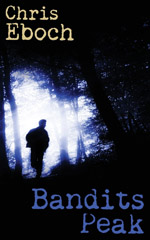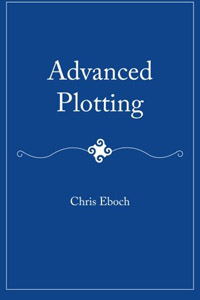by Chris Eboch
In my article “From Idea to Story: Situation & Complications” I talked about turning an idea into a story by breaking it down into four main parts: situation, complications, climax, and resolution. I covered the first two parts in that post. Now we get to the climax and resolution.
Can She Do It?!
Your character has faced complications through the middle of the story. Finally, at the climax, the main character must succeed or fail. Time is running out. The race is near the end. The girl is about to date another guy. The villain is starting the battle. One way or another, your complications have set up a situation where it’s now or never. However you get there, the climax will be strongest if it is truly the last chance. You lose tension if the reader believes the main character could fail this time, and simply try again tomorrow.
In my new romantic suspense novel, Rattled, the climax comes when the heroine is chained to the floor of a cave by a villain threatening to kill her and her friends. If she can escape, maybe she can stop the bad guys and save her friends. But the penalty for failure is death—the highest stake of all. Short stories, different genres, or novels for younger kids might have lesser stakes, but the situation should still be serious.
Tips
- Don’t rush the climax. Take the time to write the scene out in vivid detail, even if the action is happening fast. Think of how movies switch to slow motion, or use multiple shots of the same explosion, in order to give maximum impact to the climax. Use multiple senses and your main character’s thoughts and feelings to pull every bit of emotion out of the scene.
- To make the climax feel fast-paced, use mainly short sentences and short paragraphs. The reader’s eyes move more quickly down the page, giving a sense of breathless speed. (This is a useful technique for cliffhanger chapter endings as well.)
Happy Endings
The climax ends with the resolution. You could say that the resolution finishes the climax, but it comes from the situation: it’s how the main character finally meets that original challenge.
In almost all cases the main character should resolve the situation himself. No cavalry to the rescue! Today, even romance novels rarely have the hero saving the heroine; she at least helps out. We’ve been rooting for the main character to succeed, so if someone else steals the climax away from him or her, it robs the story of tension and feels unfair.
Here’s where many beginning children’s writers fail. It’s tempting to have an adult—a parent, grandparent, or teacher, or even a fairy, ghost, or other supernatural creature—step in to save the child or tell him what to do. But kids are inspired by reading about other children who tackle and resolve problems. It helps them believe that they can meet their challenges, too. When adults take over, it shows kids as powerless and dependent on grownups. So regardless of your character’s age, let your main character control the story all the way to the end (though others may assist).
Although your main character should be responsible for the resolution, she doesn’t necessarily have to succeed. She might, instead, realize that her goals have changed. The happy ending then comes from her new understanding of her real needs and wants. Some stories may even have an unhappy ending, where the main character’s failure acts as a warning to readers. This is more common in literary novels than in genre fiction.
Tip
How the main character resolves the situation—whether she succeeds or fails, and what rewards or punishments she receives—will determine the theme. To help focus your theme, ask yourself:
- What am I trying to accomplish?
- Who am I trying to reach?
- Why am I writing this?
Once you know your theme, you know where the story is going and how it must be resolved. For example, a story with the theme “Love conquers all” would have a different resolution than a story with the theme “Love cannot always survive great hardship.”
The next time you have a great idea but can’t figure out what to do with it, see if you have all four parts of the story. If not, see if you can develop that idea into a complete, dramatic story or novel by expanding your idea, complications, climax or resolution, as needed. Then readers will be asking you, “Where did you get that fabulous idea?”
 Chris Eboch writes fiction and nonfiction for all ages. In Bandits Peak, a teenage boy meets strangers hiding on the mountains and gets drawn into their crimes, until he risks his life to expose them. The Eyes of Pharaoh is an action-packed mystery set in ancient Egypt. The Genie’s Gift is an Arabian Nights-inspired fantasy adventure. In The Well of Sacrifice, a Mayan girl in ninth-century Guatemala rebels against the High Priest who sacrifices anyone challenging his power. Her writing craft books include You Can Write for Children: How to Write Great Stories, Articles, and Books for Kids and Teenagers and Advanced Plotting.
Chris Eboch writes fiction and nonfiction for all ages. In Bandits Peak, a teenage boy meets strangers hiding on the mountains and gets drawn into their crimes, until he risks his life to expose them. The Eyes of Pharaoh is an action-packed mystery set in ancient Egypt. The Genie’s Gift is an Arabian Nights-inspired fantasy adventure. In The Well of Sacrifice, a Mayan girl in ninth-century Guatemala rebels against the High Priest who sacrifices anyone challenging his power. Her writing craft books include You Can Write for Children: How to Write Great Stories, Articles, and Books for Kids and Teenagers and Advanced Plotting.
Learn more at www.chriseboch.com or her Amazon page, or check out her writing tips at her Write Like a Pro! blog. Sign up for her Workshop newsletter for classes and critique offers.
Chris also writes novels of suspense and romance for adults under the name Kris Bock; read excerpts at www.krisbock.com.
This article was originally published in the May 2011 issue of SouthWest Sage and is reprinted here by permission of the author.



Leave a Reply